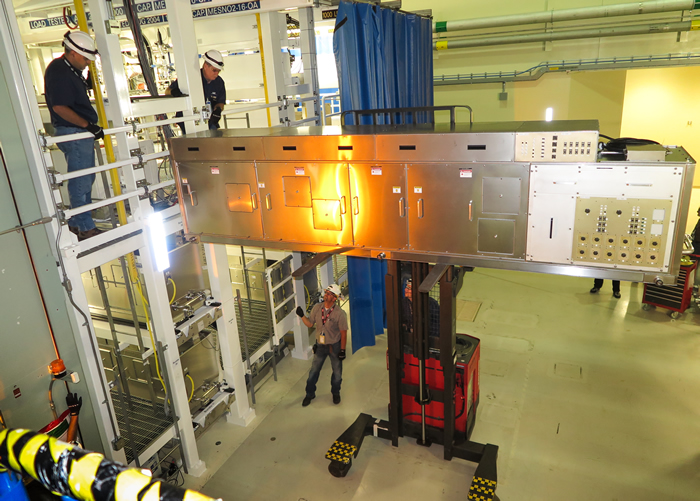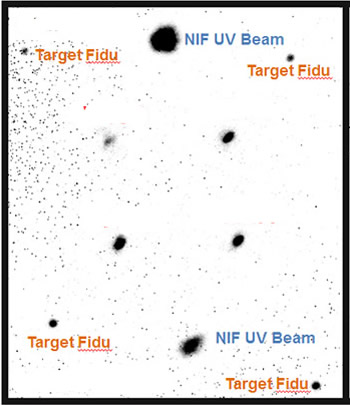Science & Technology - 2015
August
New ARC Front End Proves Its Mettle
The first Advanced Radiographic Capability (ARC) target shot using the system’s new high contrast front end was successfully fired on Aug. 30. The shot marked a significant milestone in the development of NIF’s petawatt-class laser system.
ARC is designed to produce brighter, more penetrating, higher-energy x rays than is possible with conventional radiographic techniques. The x rays will backlight and illuminate NIF targets as they implode, producing a radiographic “movie” with tens-of-picoseconds temporal resolution during the critical phases of an inertial confinement fusion experiment. The new front end was designed, developed, and deployed over the past year to improve the temporal pulse contrast produced by the ARC system’s front-end components.
 The NIF Team installing the new high contrast ARC front end system above the preamplifier module in Laser Bay 2 on June 25. Credit: James Pryatel
The NIF Team installing the new high contrast ARC front end system above the preamplifier module in Laser Bay 2 on June 25. Credit: James Pryatel ARC’s high peak power is enabled by a process called chirped-pulse amplification, in which a short, broadband pulse generated by an oscillator is stretched in time to reduce its peak intensity, then amplified at intensities below the damage threshold in the laser amplifiers, and finally compressed to a short pulse and highest peak power in large compressor vessels.
The new front-end technology is based on a short-pulse optical-parametric amplification (OPA) system similar to one deployed on the OMEGA EP (Extended Performance) Laser Facility at the University of Rochester; researchers at Rochester’s Laboratory for Laser Energetics contributed to the development of the new ARC system. The system was designed to reduce the energy of amplified “prepulses” to avoid compromising target integrity before the main pulse arrives.
 An image taken by NIF’s upper static x-ray imager diagnostic shows ARC beam spots produced during the Aug. 30 shot with the new front end; the spots are smaller and brighter than in a previous shot. The spots labeled “Target Fidu” are fiducials, or reference points. Credit: Dave Martinez (WCI), the shot’s responsible individual.
An image taken by NIF’s upper static x-ray imager diagnostic shows ARC beam spots produced during the Aug. 30 shot with the new front end; the spots are smaller and brighter than in a previous shot. The spots labeled “Target Fidu” are fiducials, or reference points. Credit: Dave Martinez (WCI), the shot’s responsible individual. “You want your main laser pulse to efficiently interact with a metal target to convert that laser energy into hard x rays that can penetrate dense matter,” explained laser physicist John Heebner, the front end’s lead scientist. “Repeating this with multiple, staggered laser pulses allows you to produce short bursts of x rays that create a strobed radiograph, or movie. If the prepulse is too high, you end up creating a plasma on the surface of the metal, and this plasma cloud prevents the main pulse from efficiently interacting with the metal.
“The first-generation front end did not have sufficient contrast ratio—that is, too much prepulse in the time preceding the main pulse,” Heebner said. “Before the main pulse arrived, there was enough energy to compromise the target before the main pulse hit it.”
Heebner said the contrast in the previous front end was limited by its fiber-based architecture. The new architecture makes use of the optical parametric amplifier and bulk stretcher, which create pulses with higher contrast ratios.
“The (Aug. 30) shot showed that we had excellent prepulse contrast,” Heebner said, “and that was the primary requirement for the upgrade that we made. In the following months we’re going to be turning the energy up and further optimizing the system for x-ray generation.
“But additionally now as we ramp up the energy, we’re going to become increasingly concerned with the pulse shape,” he said. “So we put in all the necessary controls to be able to adjust that with feedback loops. That’s going to be the next major thrust, get that pulse shape optimized so that we can extract the most energy from ARC while doing it safely. And then ultimately having the experimentalists use ARC for recording x-ray movies of the target, as it was intended to do.”



